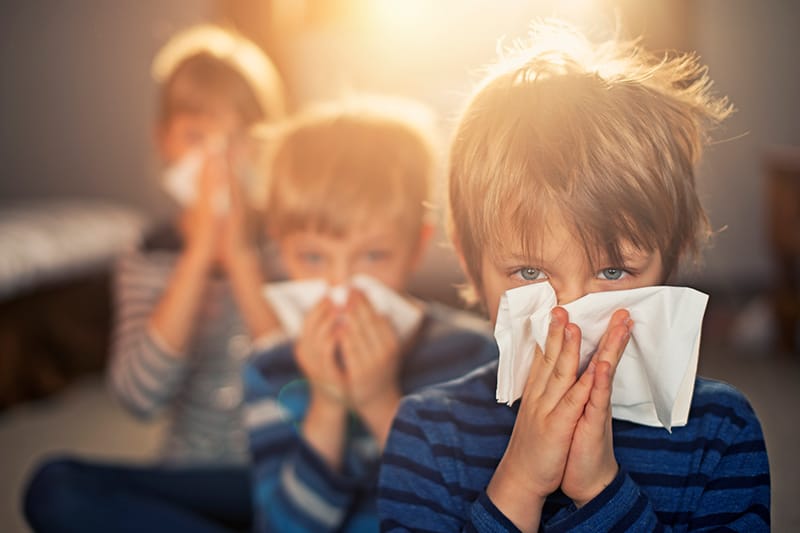Living with allergies is unpleasant at any age. To manage your symptoms or avoid reactions, you may have to take allergy medication year-round, stay away from certain foods and triggers, or ramp up your allergy management as the seasons change.
But before you get to all that, you have to know that you have an allergy. With children who’ve never had allergies before, it can be hard for you to figure out if it’s a temporary illness or a long-term trend.
The signs are subtle, so it’s important to know what common allergy symptoms look like so you can help your kid manage whatever is making them miserable.
What causes an allergy anyway?
Parents do! But not in any way that you can control. If you have allergies, there’s a 25 percent chance your children will too. If both you and your partner have allergies, the odds double to 50 percent. There are many other environmental factors which also play a role.
Just because you have a certain allergy does not mean your child will develop the same one. They inherit the gene that makes them more susceptible to allergies. There’s no telling what form that will take.
What are the most common pediatric allergies?
As you may have experienced yourself, allergies typically start in childhood. You can outgrow some allergies, but others hang around throughout adulthood and new ones show up. The most common allergies break down into three groups, based on how they are caused or where symptoms are present.
Skin Allergies
Skin allergies are the most common type in kids. They can occur as a reaction to something your child touched or as a result of a food or airborne allergy. According to the Control and Control and Prevention, nearly 14 percent of children have skin allergies, which includes eczema and allergic reactions that cause hives, rashes or swelling.
Eczema is especially common in babies and infants. It’s even more common if your baby or someone else in the family has another allergy.
Seasonal Allergies
Hay fever, allergic rhinitis, seasonal allergies — whatever you call it, it’s a common condition for kids. More than 5 million children had symptoms of hay fever in 2017. Older children ages 12 to 17 were three times more likely to have seasonal allergies than infants and toddlers.
Seasonal allergies have been shown to negatively impact how children sleep and perform at school. The signs look an awful lot like cold symptoms, which can make it harder to pinpoint the problem. Over time, wheezing and shortness of breath can worsen into full-blown asthma.
Food Allergies
Skin and seasonal allergies are more common, but food allergies make more headlines because serious reactions can be deadly. Food allergies can cause shortness of breath or swelling that closes the airways.
Less than seven percent of children have a food allergy. The most common culprits — peanuts, eggs, milk (lactose), wheat, soy, tree nuts, fish and shellfish — account for 90 percent of food allergies.
Unlike other allergies, children can sometimes grow out of food allergies or become desensitized to the food that causes their reaction, but it depends on the food. Kids who are allergic to milk, egg, soy or wheat have a better shot at outgrowing their allergies by the age of five.
Which allergy symptoms should I look for in my child?
Sometimes allergies are easy to spot. Your kid will have a sudden, intense reaction to an allergen. And you can look into the recent past to pinpoint the culprit. In other cases, the signs are subtle, similar to other known conditions, or slowly worsen and become more noticeable over time. If you see any of these signs, take your concerns to your pediatrician or an allergy specialist:
- Itchy, red skin or patches of bumps that don’t go away with topical treatments
- Hives
- Chronic cold-like symptoms that last for two or more weeks or come seasonally
- Constant nose rubbing, sniffling, snorting or sneezing
- Itchy, runny eyes or nose
- Itching or tingling in the mouth or throat
- Coughing, wheezing or trouble breathing
- Diarrhea, cramps and stomach issues
What kind of allergies and symptoms do babies get?
Any time a health issue — allergy or otherwise — affects your baby, your concerns are magnified. Babies can’t describe the more subtle symptoms to you. And you know they lack the immune system to easily fight off the illnesses and infections that you can.
Babies can experience all the same allergies as older kids. Reactions to certain foods and medications usually happen pretty quickly. Within a few minutes or up to a couple of hours, rashes, hives, itching, wheezing or shortness of breath can occur. They may also show more noticeable signs like vomiting or crying from abdominal pain.
It may take you a while to recognize a pattern of seasonal allergies, but babies can get reactions from those plant-based allergens and pollens as well as mold, dust mites and animals. Babies have smooth, sensitive skin, so rough clothing, shampoos, soaps and detergents can cause skin reactions. The symptoms of both seasonal and skin allergies are the same as for kids of all ages.
You can’t prevent your kids from getting allergies, but you can prevent them from having allergic reactions and dealing with chronic symptoms. And while it’s easy to try some home remedies or over-the-counter medications for allergies that have worked for you in the past, you should always consult your pediatrician first. Your doctor can help you figure what type of allergy is occurring and the best way to manage your child’s symptoms.


